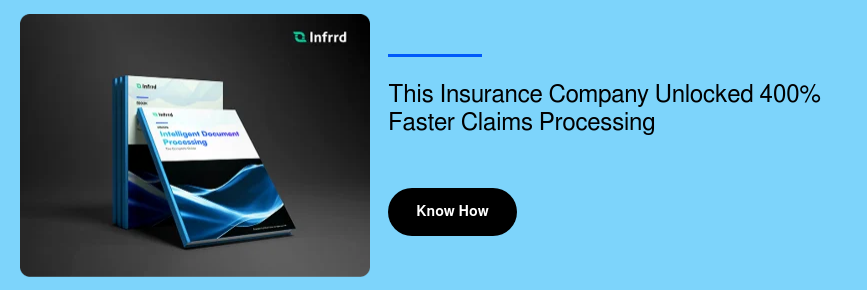With the evolution of technology and tech-based apparatus, insurance companies continually seek ways to expand operational efficiency, reduce costs, and drive growth. But how can they do so?
Intelligent document processing (IDP) is a dynamic tool that helps the insurance sector to streamline document-intensive processes, optimize resource allocation, and improve accuracy. By leveraging artificial intelligence (AI), machine learning (ML), and other chains of operations, IDP advances insurance document processing workflows by automating tasks such as data entry, sorting, and classification.
This article is an in-depth analysis of how IDP is implemented in the insurance documentation process, directly impacting growth and development.
What is Intelligent Document Processing?
Intelligent document processing is an innovative mechanism that allows computer systems to capture, operate, validate, and evaluate data from multiple databases. Deploying AI to automate data capture, Intelligent Document Processing makes it easier for businesses to quickly extract data while providing real-time analytics and accurate document processing. These systems use natural language processing (NLP) computations - to interpret and analyze the textual data in documents.
Top 8 Ways IDP Impacts the Insurance Sector to Drive Growth and Reduce Costs
Insurance documentation processing incorporates regulating, organizing, and processing insurance documents. Through IDP, the insurance industry can help insurers leverage enormous amounts of data by effectively extracting insights from contracts or consumer forms - without human intervention. Here’s an overview of how IDP impacts the insurance industry that, helps drive growth and reduces costs:
Documents Sorting and Classification with IDP

Insurance companies receive loads of documents from agents, policyholders, and other stakeholders. Upon notice, these documents must be sorted and classified based on their respective category and objectives. This step entails identifying the document’s type (policy document, claims forms, etc.) - to ensure handling and processing. The manual classification of insurance documents is an expensive and time-consuming process. Additionally, it requires pre-sorting before any processing activities commence.
However, Intelligent Document Processing eradicates the need for document pre-sorting or separation, providing end-to-end automation to document-centric business processes. By labeling and tagging documents using categories, this technology can easily sort, classify, identify, and organize texts or graphics. IDP learns, and can auto-classify single-or-multi-page documents, allowing a massive reduction in cost and a boost in growth.
Data Extraction with IDP

Relevant data components must be extracted from the documents to settle insurance databases and system issues. IDP can derive comprehensive data for insurance businesses from textual and visual materials. This process may involve manual data entry or automated data analysis using technologies such as Optical Character Recognition (OCR) or Intelligent Document Processing (IDP) - to obtain data from scanned or digital documents.
Additionally, once data is extracted from the insurance; it must go through a series of validation rules and AI-driven techniques - to determine the extraction results. IDP makes the process easier by indexing and analyzing entire categories of documents where manual operations would have been impossible.
Data Validation and Verification with IDP

The data must be validated and verified for precision and totality when extracted from insurance records. This process includes cross-referencing information against internal databases, system records, and external sources - to authorize data to be up to date. IDP can significantly help with data validation and verification, as it employs AI and ML algorithms to automatically extract data and eliminate manual entry. Therefore, it helps reduce the risk of human inconsistencies and ensures accurate and consistent data capture.
Additionally, Intelligent Document Processing systems often provide confidence scores or levels associated with the extracted data. These scores indicate the system's level of certainty about the accuracy of the extracted information. Low confidence scores can trigger a manual review or additional verification steps. By analyzing patterns and historical data, these models can help identify potential errors or anomalies and provide more accurate validation results over time. As a result, the insurance sector can greatly benefit from its implementation.
Process of Underwriting and Policy Administration with IDP

Insurance documentation plays a crucial role in underwriting processes. Insurance policies must be reviewed, approved, and administered based on established guidelines and risk assessments. Insurance document processing involves assessing policy details, endorsements, coverage limits, and exclusions to ensure accuracy and compliance. IDP can automatically generate policy documents based on the data extraction. This streamlines the policy administration process, ensuring accurate and consistent documentation.
Further, Intelligent Document Processing aids in insurance risk assessment and underwriting decision support by analyzing extracted data from applications, supporting documents, and external sources. As a result, it helps provide accurate and relevant data promptly while enhancing the underwriting process and risk evaluation. Additionally, IDP can contribute to insurance fraud detection and prevention by identifying inconsistencies or suspicious patterns in the extracted data. It can flag potential fraud indicators, such as mismatched information, unusual claim patterns, or inconsistent policy details, helping insurers identify and investigate fraudulent activities.
Documents Claims Processing with IDP

Claims-related documentation requires careful processing to assess claims' validity, coverage, and settlement. Insurance companies review claim forms, supporting documentation, and evidence to evaluate and process claims efficiently. Intelligent Document Processing is crucial in claims processing within the insurance industry. The process begins by receiving and digitizing claim-related documents. These documents can include claim forms, medical records, police reports, photographs, and any other supporting documentation. IDP assesses their content and purpose by employing machine learning algorithms to classify and categorize the received documents. This helps streamline the subsequent processing steps and route documents to the appropriate teams or systems.
IDP integrates with existing claims management systems or workflow platforms using advanced machine learning techniques to automate the claims processing workflow. It automatically routes the documents and extracted data to the relevant teams, such as claims adjusters, underwriters, medical reviewers, or fraud investigation units. Next, it helps provide data-driven insights and analysis to support claims decision-making. Claims adjusters can utilize the extracted data, validation results, and fraud detection indicators to assess the claim, make informed decisions, learn, and determine appropriate settlements.
Documents Security and Data Privacy with IDP

Insurance documentation processing requires stringent measures to ensure data security and privacy. Compliance with data protection regulations, secure storage, access controls, and encryption is crucial to protect sensitive information and maintain customer confidentiality. IDP solutions are designed with a strong focus on insurance document security and data privacy. It employs encryption techniques to protect sensitive data during transit and storage. Encryption helps safeguard the confidentiality of the data, ensuring that only authorized individuals can access and view it.
Additionally, Intelligent Document Processing solutions maintain detailed audit trails and activity logs that capture all document-related activities. This includes information on document access, modifications, and user interactions. Audit trails enable tracking and monitoring of document handling, ensuring accountability and facilitating compliance audits.
Top Benefits of Intelligent Document Processing (IDP) in the Insurance Industry

IDP is a process that streamlines the analysis and processing of documents with the help of advanced tools and technologies, including machine learning and AI. Some of the top benefits of using Intelligent Document Processing in the insurance industry are:
Increased Efficiency: Intelligent Document Processing automates time-consuming manual tasks involved in insurance document processing, such as data entry, sorting, and classification. It accelerates document processing workflows by using AI algorithms to analyze and extract data from documents, leading to significant time savings and increased operational efficiency.
Enhanced Accuracy: Manual document processing is prone to human errors, such as data entry mistakes or misinterpretation of information. IDP minimizes these errors by leveraging machine learning models to accurately recognize and extract relevant document data - thus, ensuring each entry is properly assigned without any human error.
Faster Processing and Response Times: IDP significantly reduces turnaround times for operational insurance processes by automating document processing. Whether it's processing insurance claims or invoices, IDP can expedite the entire process, leading to faster response times to customers or clients.
Cost Savings: IDP can help cut down the substantial cost savings for the insurance sector. Simply put, automating documentation processing will reduce the need for extensive manual labor, cutting operational costs.
Implement Intelligent Document Processing with Infrrd
Tired of the inefficiencies and manual errors that come with processing large volumes of documents in your organization? Say hello to Infrrd’s IDP! Implementing intelligent document processing in an insurance organization is easy with our IDP technology. We use advanced AI-powered document processing systems with built-in security measures such as encryption algorithms, which help protect customer data from external threats. And so, data security is not an issue for us!
Infrrd’s IDP goes beyond simple automation—it leverages AI and machine learning to ensure that data extraction is accurate, efficient, and scalable. Whether you’re handling claims, underwriting documents, or policy agreements, our IDP solution streamlines workflows, reducing human errors and improving turnaround times. By automating document processing, insurance organizations can free up valuable human resources to focus on more complex and strategic tasks.
Visit our website and take home 100% accurate document processing results.
Let's Wrap Up the 'Process'!
Intelligent document processing provides the insurance sector with a cost-effective and highly efficient solution for managing vast amounts of documentation. Traditional document handling methods are time-consuming, prone to errors, and expensive. However, IDP eliminates these inefficiencies by automating data extraction, classification, validation, and analysis. By doing so, insurance organizations can significantly cut costs while improving accuracy and operational efficiency.
One of the key benefits of intelligent document processing is its ability to streamline claims processing. By automating data capture from claim forms, medical records, and supporting documents, IDP ensures that claims are processed faster and more accurately. This reduces delays, improves customer satisfaction, and minimizes fraudulent activities. With real-time data validation, insurance companies can make more informed decisions, ensuring compliance with regulatory standards.
Moreover, IDP enhances policy management by automating data extraction from customer applications, contracts, and endorsements. This eliminates the need for manual entry, reducing the risk of errors and inconsistencies. Insurance companies can also leverage IDP to increase document understanding and identify trends, helping them refine risk assessment models and improve underwriting accuracy.
Security and compliance are major concerns in the insurance sector, given the sensitive nature of customer data. Infrrd’s IDP comes with robust security features, including encryption, access control, and audit trails, ensuring that all data is handled securely. Organizations can confidently adopt IDP, knowing that their data is protected from breaches and cyber threats.
While intelligent document processing offers numerous advantages, insurance organizations must ensure proper implementation for optimal results. Selecting the right IDP solution, integrating it seamlessly into existing workflows, and providing adequate training to employees are crucial steps in maximizing its benefits.
Insurance companies are constantly seeking solutions to enhance efficiency, reduce risks, and drive growth. IDP is the key to achieving these goals, offering automation-driven document processing that transforms insurance operations. With intelligent document processing, insurance companies can streamline their workflows, optimize resource utilization, and ultimately deliver better services to their customers.
Now is the time to embrace automation and take your insurance operations to the next level. Implement IDP with Infrrd today and unlock the full potential of your organization!
FAQs
IDP (Intelligent Document Processing) enhances audit QC by automatically extracting and analyzing data from loan files and documents, ensuring accuracy, compliance, and quality. It streamlines the review process, reduces errors, and ensures that all documentation meets regulatory standards and company policies, making audits more efficient and reliable.
Yes, IDP uses advanced image processing techniques to enhance low-quality documents, improving data extraction accuracy even in challenging conditions.
IDP efficiently processes both structured and unstructured data, enabling businesses to extract relevant information from various document types seamlessly.
IDP combines advanced AI algorithms with OCR to enhance accuracy, allowing for better understanding of document context and complex layouts.
IDP platforms can seamlessly integrate with ERP, CRM, and other enterprise systems, ensuring smooth data flow across departments.
IDP leverages AI-driven validation techniques to ensure that extracted data is accurate, reducing human errors and improving overall data quality.









